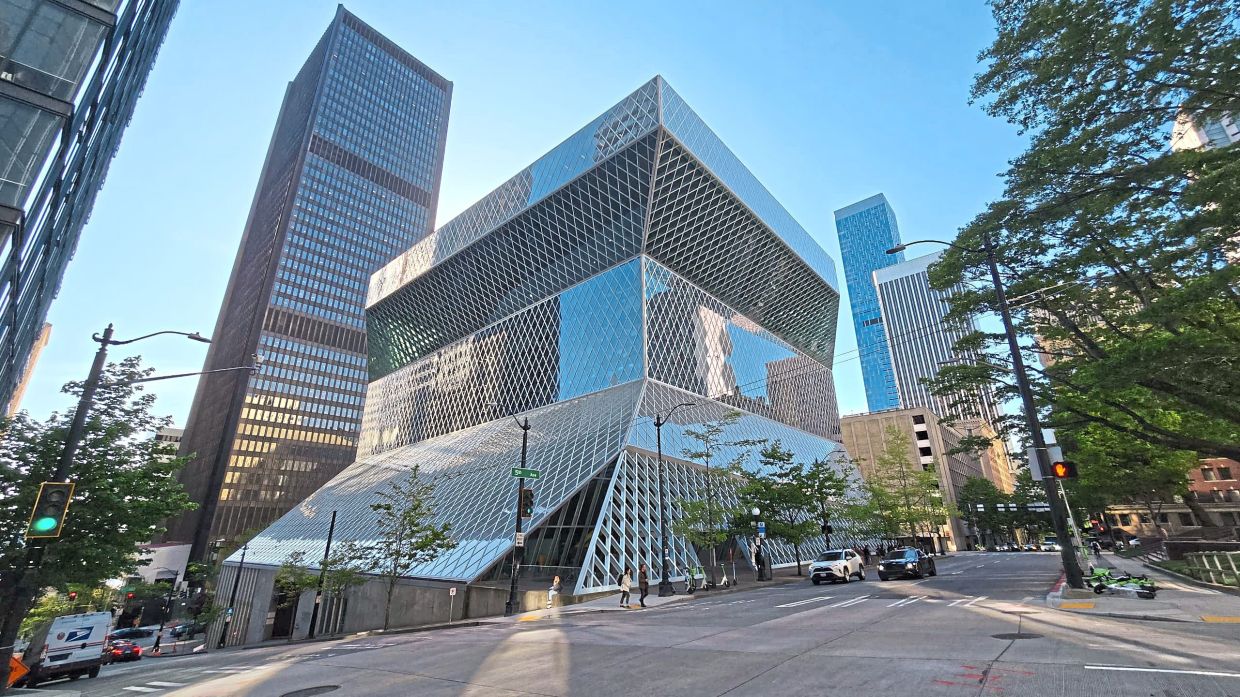From afar, the Seattle Public Library takes the form of stacked boxes in shifting planes and volumes. Photos: Tan Bee Eu
When it opened to the public on May 23, 2004, the Seattle Public Library in the United States shook the world by storm. The architectural design is unconventional and unique, characterised by a glass and steel facade of diamond-shaped grid patterns.
With a size of 33,700sq m, it accommodates half a million books, 400 computers and 143 parking lots.
From afar, the library takes the form of stacked boxes in shifting planes and volumes. I was speechless when I visited it. It was such a jaw-dropping sight!
The library was designed by renowned Dutch architect Rem Koolhaas and his firm, the Office for Metropolitan Architecture (OMA), in partnership with LMN Architects. The completed building won numerous prestigious awards, such as the American Institute of Architects (AIA) Honor Award for Architecture, for its distinct architectural design and intricate design process.
OMA had a strong vision to redefine the library as a repository of knowledge and information, not just in the form of physical books, but also all forms of media.
Form follows function
How did the architects derive such a funky and abstract-looking building? Inspired by the changing nature of knowledge, the architectural icon was designed based on the principles of “form follows function”.
The architect worked closely with the chief librarian to define five clear functional zones or “platforms” – Administrative, Books, Meeting, Information and Parking. The five zones were treated like five boxes stacked and moved around to capture light, shade, shadow and the surrounding vistas of the city.
From the pile of stacked forms, the architects merely connected the corners of the shifting platforms, creating the bold striking structure you see today.
Library as public realm
As we embrace ever-ready digital information from our smartphones, libraries are at a high risk of being obsolete and forgotten by the community.
The architects understood this well and decided to emphasise the creation of public spaces to promote community interaction and engagement.
The Seattle Public Library is not just all books but also features expansive open areas, well-equipped meeting rooms, and a spacious auditorium tailored for public events.
The deliberate strategy of creating high visual connectivity between floors works like magic in providing a warm sense of welcome to visitors. Visitors who never intend to read find themselves inspired to do so while visiting the interior spaces. That’s the power of architecture in influencing positive actions!
Bookshelves on a ramp
Can you imagine walking through library spaces laid on a huge continuous ramp? That’s exactly what the architects designed. “Books Spiral” is a clever idea proposed to connect four levels of bookshelves that sit on an inclined floor.
The gradient is gentle and makes it extremely easy for users to navigate different floors without climbing any stairs. Wonderful, I smiled, as I traversed the floor of endless bookshelves. Perfect for the elderly! Such a simple yet innovative concept of merging a car park-styled ramp with multiple floors of bookshelves. I love it!
Natural lighting and the outdoors
The central library celebrates the abundance of natural light to minimise energy usage. With voluminous high ceilings, the interiors are gloriously inspiring with a comfortable illumination of natural light. The reading spaces felt like an inspiring temple of knowledge. At every corner I walk to, my eyes are visually connected to the blue skies and the cityscape surrounding the building.
This simple connection to the outdoors works wonders when your eyes are tired from staring at your book or computer screen. The framed views from its large glass windows are amazing and delightful to the senses. These intentional decisions not only enhance the building’s overall sustainability but also significantly lessen its environmental footprint.
Fast forward 20 years after its completion and the Seattle Public Library is still a strong icon. A remarkable architectural achievement that seamlessly blends form and function. Its bold and imaginative design not only serves the community effectively but also captivates and inspires admiration as a vibrant public space.
It’s an inspirational building that changed the image of a conventional library as an institutional building.
Tan Bee Eu is a professional architect and interior designer registered with Lembaga Arkitek Malaysia with over two decades of professional practice. She also teaches at Universiti Sains Malaysia and is a frequent keynote speaker at architectural forums and juror of international awards. She can be reached at www.betadesignz.com/contact.









